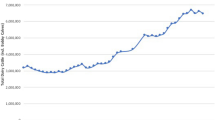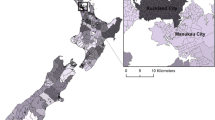Abstract
This paper characterises the dairy farming system in Dagoretti, Nairobi. Characterisation was part of a broader ecohealth project to estimate the prevalence and risk of cryptosporidiosis and develop risk mitigation strategies. In the project a trans-disciplinary team addressed epidemiological, socioeconomic, environmental and policy aspects of cryptosporidiosis, an emerging zoonosis. This paper also provides background and describes sampling methods for the wider project. Three hundred dairy households were probabilistically sampled from a sampling frame of all dairy households in five of the six locations of Dagoretti, one of the eight districts of Nairobi Province. Randomly selected households identified 100 non-dairy-keeping households who also took part in the study. A household questionnaire was developed, pre-tested and administered in the dry and wet seasons of 2006. An additional study on livelihood and economic benefits of dairying took place with 100 dairy farmers randomly selected from the 300 farms (as well as 40 non-dairy neighbours as a control group), and a risk-targeted survey of environmental contamination with Cryptosporidium was conducted with 20 farmers randomly selected from the 29 farmers in the wider survey who were considered at high risk because of farming system. We found that around 1 in 80 urban households kept dairy cattle with an average of three cattle per household. Cross-breeds of exotic and local cattle predominate. Heads of dairy-keeping households were significantly less educated than the heads of non-dairy neighbours, had lived in Dagoretti for significantly longer and had significantly larger households. There was a high turnover of 10 % of the cattle population in the 3-month period of the study. Cattle were zero grazed, but productivity parameters were sub-optimal as were hygiene and husbandry practices. In conclusion, dairy keeping is a minor activity in urban Nairobi but important to households involved and their community. Ecohealth approaches are well suited to tackling the complex problem of assessing and managing emerging zoonoses in urban settings.

Similar content being viewed by others
References
CBS, 1999. Population and housing census, Volume I. Central Bureau of Statistics, Ministry of Finance and Planning, Nairobi, Kenya
Cole, D., Grace, D. and Diamond, M., 2008. Researcher’ approaches to evidence on urban agriculture and human health. In: Cole D., Lee-Smith D. and Nasinyama G. (eds) Healthy city harvests: Generating evidence to guide policy on urban agriculture, (International Potato Center (CIP) and Makerere University Press).
EADD, 2009. Survey methodology and overview key results of the household indicators, East Africa Dairy Development (EADD) (Project baseline surveys report, East African Dairy Development Project)
Foeken, D. and Owuor, S.O., 2000. Livestock in a Middle-Sized East-Africa town: the case of Nakuru, (African Studies Centre, Leiden).
Gatei, W., Wamae, C.N., Mbae, C., Waruru, A., Mulinge, E., Waithera, T., Gatika,S.M., Kamwati,S.K., Revathi, G. and Hart, C.A., 2006. Cryptosporidiosis: prevalence, genotype analysis, and symptoms associated with infections in children in Kenya. American Journal of Tropical Medicine and Hygiene.75(1), 78–82.
Grace D., Randolph T., Olawoye J., Dipelou M. and Kang’ethe E., 2008. Participatory risk assessment: a new approach for safer food in vulnerable African communities. Development in Practice, 18(4), 611–618
Kang’ethe, E.K., 2005. Characterization of Benefits and Health Risks Associated with Urban Smallholder Dairy Production in Dagoretti Division, Nairobi, Kenya, (Final technical report submitted to IDRC, Canada).
Kang’ethe, E.K., 2007. Editorial: potential of urban agriculture; benefits and risks. East African Medical Journal, S45–S47.
Kang’ethe, E.K., Njehu, A.N., Karanja, N., Njenga, M., KuriaGathuru, and Karanja, A., 2008. Benefits and selected health risks of urban dairy production in Nakuru, Kenya. In: D. Cole. D. Lee-Smith and G. Nasinyama (eds), Healthy city harvests: Generating evidence to guide policy on urban agriculture, (International Potato Center, Nairobi and Makerere University Press, Kampala).
Kang’ethe, E.K. and Lang’at, A., 2009. An investigation of Aflatoxin B1 and M1 contamination of animal feeds and milk from urban centres in Kenya, African Health Sciences, 9(4), 218–226.
Lee Smith, D. and Cole, D., 2008. Can the city produce healthy food? In: D. Cole. D. Lee-Smith and G. Nasinyama (eds), Healthy city harvests: Generating evidence to guide policy on urban agriculture, (International Potato Center, Nairobi and Makerere University Press, Kampala).
Mlozi, M.R.S., 2005. Urban animal agriculture: its palliativity and reasons for persistence in Tanzanian towns, (RICS, London).
MORAD, 2002. Ministry of Agriculture & Rural Development annual report 2002, (MORAD, Kenya).
Oxfam, 2009 Urban Poverty and Vulnerability in Kenya, http://www.oxfam.org.uk/resources/policy/conflict_disasters/downloads/bn_urban_poverty_kenya.pdf. Accessed: 10th July, 2011
R Development Core Team (2007). R: A language and environment for statistical computing. R Foundation for Statistical Computing, Vienna, Austria. ISBN 3-900051-07-0, URL http://www.R-project.org.
SDP, 2005. The uncertainty of cattle numbers in Kenya, (SDP Policy Brief 10, Smallholder Dairy (R&D) Project, Nairobi).
Tegegne, A., 2004. Urban livestock production and gender in Addis Ababa, Ethiopia Urban Agriculture Magazine, 12, 30–31.
Thorpe, W., Morris, C.A. and Kang’ethe, P., 1994. Crossbreeding of Ayrshire, Brown Swiss, and Sahiwalcattle for annual and lifetime milk yield in the lowland tropics of Kenya, Journal of Dairy Science, 17, 2415–2427.
Waltner-Toews, D., 2009. Ecohealth, a primer for veterinarians, Canadian Veterinary Journal, 50(5), 519–521.
Acknowledgments
The authors wish to thank the International Research Development Centre for funding this work under the grant 103075-001. We also thank all the members of the Dagoretti small agriculture and small livestock extension team and all the members of the Dagoretti community who took part in this study.
Author information
Authors and Affiliations
Corresponding author
Rights and permissions
About this article
Cite this article
Kang’ethe, E.K., Kimani, V.N., McDermott, B. et al. A trans-disciplinary study on the health risks of cryptosporidiosis from dairy systems in Dagoretti, Nairobi, Kenya: study background and farming system characteristics. Trop Anim Health Prod 44 (Suppl 1), 3–10 (2012). https://doi.org/10.1007/s11250-012-0199-9
Accepted:
Published:
Issue Date:
DOI: https://doi.org/10.1007/s11250-012-0199-9




